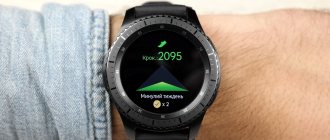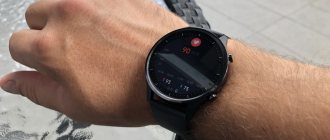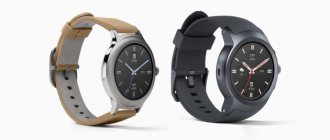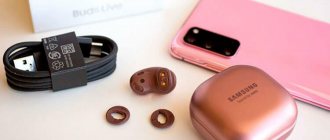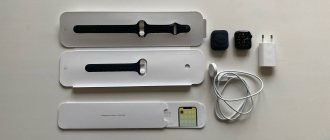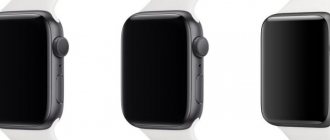The Fitbit Ionic smart watch was developed as an alternative to Apple Watch products and smart bracelets based on the Android Wear operating system. The product is aimed at users who lead an active lifestyle and monitor physical activity parameters. The device can be paired with mobile phones based on iOS and Android platforms; a list of compatible smartphones is available on the manufacturer’s website.
Fitbit Ionic is a sports watch that can track the user's physical activity.
Description of the Fitbit Ionic smart watch
Smartwatches from Fitbit are designed for training and navigation. The product is built on the original Fitbit OS platform, which supports gesture commands (used to unlock the screen).
The equipment supports several training modes with automatic selection of the required function. The user can purchase additional profiles in the company's company store. The manual included in the kit in Russian helps you set up the product and start using it.
The best Fitbit devices
If you're looking for a new tracker or wondering what Fitbit you have, check out the data in this table.
| device | screen | GPS | Automatic exercise detection | Heart rate | Swim-proof |
| Fitbit Charge 3 | Yes | No (only connected GPS) | Yes | Yes | Yes |
| Fitbit Inspire HR | Yes | No (only connected GPS) | Yes | Yes | Yes |
| Fitbit Inspire | Yes | No | Yes | No | Yes |
| Fitbit Alta XP | Yes | No | No | Yes | No |
| Fitbit Alta | Yes | No | No | No | No |
| Fitbit Flex 2 | No | No | No | No | Yes |
| Fitbit Versa | Yes | No (only connected GPS) | Yes | Yes | Yes |
| Fitbit Versa Lite Edition | Yes | No (only connected GPS) | Yes | Yes | No |
| Fitbit Ionic | Yes | Yes | Yes | Yes | Yes |
| Fitbit Blaze | Yes | No (only connected GPS) | Yes | Yes | No |
Fitbit fitness trackers
Fitbit Charge 3
£129.99, Amazon | fitbit.com
It's Fitbit's most advanced sports fitness brand, with an SpO2 heart rate sensor that tracks your specific gravity per minute 24/7. You can track workout range but no GPS - take your phone for a run/cycle and that will solve the issue. The large screen shows your day's stats and progress toward goals, as well as some smartphone notifications.
Fitbit Inspire HR
£89.99, Amazon | fitbit.com
Essentially acting as a replacement for the now-discontinued Alta and Alta HR (below), the Inspire HR and Inspire (£69.99) take inspiration from the Charge line and cut back on bulk. There's swim protection, step tracking, sleep tracking, notifications and automatic workout tracking, and five days of battery life.
The heart rate monitor has additional features including 24/7 heart rate tracking, sleep stages, guided breathing, connected GPS and targeted exercise modes.
Fitbit Alta XP
£129.99, Amazon | fitbit.com
A 2020 fitness tracker, the Alta HR offers a really strong balance of features in a small, discreet design. You still get heart rate tracking and advanced sleep stats, as well as all the usual step-tracking features—though the screen is too small for notifications and there's no connected GPS for workouts.
While both the Alta HR and Alta have now been discontinued and are not available through Fitbit, they are still available on Amazon.
Fitbit Flex 2
£69.99, Amazon | fitbit.com
The cheapest tracker in the range, the screenless Flex2 simply tracks your steps and sleep using basic hand tracking. You'll also need to go to the Fitbit app to see detailed progress. However, it has a hidden superpower - it's swim-resistant for basic tracking of pool sessions, something only matched by the latest trackers in the company's line.
To the point
The Best Waterproof Fitness Trackers for Swimming
Although the Flex 2 has now been discontinued and is no longer available from Fitbit, the tracker can be purchased on Amazon.
Fitbit Ace 2
£69.99, Amazon | fitbit.com
Released in summer 2020, Ace 2 is intended for children aged six and up, down from the original Ace's age of eight and up. It comes in fresh colors with a more durable design that makes the display safer when kids are running and playing. Adults will be able to track their kids' steps, activity and sleep as before, but this time also track activity in the pool thanks to the swim-proof design.
Fitbit Ace
£79.99, Amazon | fitbit.com
Ace is intended for children aged eight years and older. It will do basic fitness tracking, and even kids can benefit from some motivation, especially from a tracker that looks like an adult. You can also create challenges for your children among other family members or friends. It doesn't have the chore and reward systems that Garmin put in the Vivofit Jr. line, but it does have the features you need.
Fitbit smart watch
Fitbit Versa
£199.99, Amazon | fitbit.com
For those who want (almost) the full range of Fitbit features in Smart Watch form, the Versa is the best choice. Step and sleep tracking is enhanced by heart rate - and there's an advanced SpO2 sensor on board that will usher in future health features. You also get smartphone notifications plus Fitbit Pay, and it will use GPS from the paired phone.
Fitbit Versa Lite Edition
£149.99, Amazon | fitbit.com
When the original Versa proved to be a success, it's no surprise that Fitbit began releasing more affordable versions. There's no built-in storage for music, Fitbit Pay, swim lap tracking, or an altimeter, but everything else survives on the new device—things like the swim-resistant design, Fitbit OS, workout modes, heart rate monitor, and SpO2 sensor.
Fitbit Ionic
£279.99, Amazon | fitbit.com
Its aggressive, sporty styling gives it away - the Fitbit Ionic is the only watch in the line that has built-in GPS for tracking your mileage outdoors without your phone. The company's advanced heart rate sensor is also on board for accurate calorie and sleep tracking, as well as during tracked workouts.
Fitbit Blaze
£159.99, Amazon | fitbit.com
The company's first smartwatch offering wasn't a big success, but the Blaze is great for people who want tracker features (steps, sleep, and heart rate) in a wristwatch. But it's unknown whether it will continue to exist, with Blaze officially discontinued and only available through retailers like Amazon.
What is included
Overview of the components included in the watch kit:
- head product;
- battery charging cable;
- set of belts (sizes S and L);
- storage case;
- user manual.
The Fitbit Ionic comes with a charger cable in the box, as well as an extra strap.
Bottom line
Despite the limited number of available apps and problems with responding to messages, Fitbit has managed to break into the smartwatch market. The Fitbit Ionic's accurate, multi-activity tracking, long-lasting battery, and stylish, comfortable straps are a great start to a new series of wearables. Considering that this was only the first version of Ionic, we should expect improvements in the future.
Fitness watches usually become obsolete before they fail. Every year new versions appear, technology improves - one can hope that the release of new models will not interfere with the release of updates for Ionic.
This gadget is designed for athletes for whom it is important to record all their successes and create a training program. A user-friendly application and automatic activity detection mean you don't have to spend a lot of time on setup. Hardcore smartwatch fans will be left unsatisfied due to the lack of smart features and available apps. Apple Watch costs $30 (RUR 1,800) more, but offers much more features.
Benefits of Fitbit Ionic
- Very durable battery
- Automatic activity tracking
- Water resistant up to 50 meters
- Convenient, replaceable straps
- Up to 300 songs included
Disadvantages of Ionic
- Mediocre apps
- Can't reply to messages
- Lack of features
Appearance and Design
The Ionic product is equipped with a metal rectangular body with rounded edges and corners. The manufacturer offers 3 modifications of the watch, which differ in the color of the case and strap. The user can purchase additional straps of a different color, matching the mount to the color of the clothing.
The Fitbit ionic's design beats out many smartwatches in most categories.
The straps are distinguished by the shape of the perforation; in addition to standard silicone products, there is a fastening made of genuine leather. The belts are equipped with a metal clasp with step-by-step length adjustment (selected according to wrist size).
More affordable price than Ionic
Although the Ionic was a great device, its price ($300) still turned off many users. Therefore, the Versa is more affordable with an official price of $200. For this price, the smartwatch takes all the features of the Ionic, but must make a compromise by getting rid of the GPS.
Inside the box you will find a watch, a charging cable, a docking station, and two bands (small and large).
The Versa offers good value for money.
Specifications
The product consists of a body frame made of polished aluminum alloy, which is equipped with brackets for attaching a belt. There are control buttons on the side faces, and on the back wall there is a heart rate sensor and a connector for connecting the charger. The watch has a Bluetooth unit (used for connecting headsets). By eliminating the connectors, it was possible to ensure the tightness of the case design; the manufacturer allows long-term immersion of the bracelet under water to a depth of 50 m (protection standard WR50).
Fitbit Ionic is a smartwatch, waterproof, with a touch screen and support for notifications.
Product technical parameters:
- screen diagonal - 1.42 inches;
- resolution - 348*250 pixels;
- number of pixels per inch - 302 pcs.;
- built-in memory - 2.5 GB;
- weight - 45-47 g (depending on the length of the strap).
The manufacturer has provided for the installation of a controller for NFC contactless payments. The GPS/GLONASS navigation system sensor provides coordinate determination with a frequency of 1 time per second.
To measure heart rate, an optical sensor is used, consisting of 3 elements of green, red and orange. The sensor provides continuous recording of information, the received data is transferred to the application for plotting.
↑ Fitbit Versa: Display
The Fitbit Versa's backlit LCD display is about 1.4 inches (24mm x 24mm) with a 300 x 300 pixel resolution and Gorilla Glass 3 protection. The display is slightly smaller than the one on the Ionic and is not as easy to read on a daily basis, but it's not a disaster. Otherwise, the display is perfectly readable, whether in bright or poor light. The same goes for when you're swimming and want to check information underwater (yes, the Versa is waterproof with a depth limit of 50 meters).
The Versa's interface and display are a pleasant surprise.
The navigation interface is the same as in Ionic. The menus are clear and intuitive, responsiveness is beyond praise. It's unfortunate, however, that only a few third-party apps offer new wallpapers, contrary to what the Apple Watch offers.
Main functionality
Main functions of the Ionic watch:
- determining the number of steps and floors walked per day;
- calculating the distance traveled in 24 hours (using a mathematical algorithm or signals from GPS);
- determination of heart rate with display of information on the display and collection of statistics;
- counting the number of calories burned during training;
- automatic detection of training type;
- calculation of rest time taking into account sleep phases;
- building individual training schemes;
- special gymnastics regimen to control breathing;
- reminder to warm up;
- measuring the swim distance taking into account the time spent;
- displaying information about incoming calls and messages from social networks;
- music playback in MP3 format;
- ability to connect headphones via Bluetooth.
The Fitbit Ionic is a feature-packed watch that can help you track basic activities.
Clock settings
Setting up the equipment begins with charging the built-in battery; the manufacturer recommends keeping the product connected to the USB connector for 2-3 hours. Next, you need to install the Fitbit app (available for iOS, Android, and Windows Phone smartphones). The manufacturer has provided the ability to pair the bracelet with a computer. After launching the utility, you must go through the registration procedure for a new user or enter information about an already registered owner.
After launching the utility, a dialog box will appear on the smartphone screen in which you select the Ionic bracelet. The device search starts automatically; to speed up the pairing procedure, it is recommended to place the bracelet at a distance of 300-400 mm from the mobile device. After detecting the bracelet, a 4-digit digital password will be displayed on the watch and phone displays (the codes must be identical).
The utility programs individual user parameters (height, weight, age and gender), which are used to develop training programs and calculate calories burned. The manufacturer reminds that the bracelet is not a medical device; the results obtained are for informational purposes only.
The current date and time can be adjusted manually or synchronized with the information in the smartphone.
To control the functions of the watch, a touch display is used; the user switches screens by moving a finger across the protective glass. The bracelet's firmware supports programming timers or alarms. A speaker is used to notify the owner, and a vibration signal with adjustable intensity is provided. The display backlight is changed manually or based on signals from the light sensor. Additionally, the speaker volume is adjustable.
Comparing Fitbit Flex, Fitbit Charge HR and Fitbit Surge by features and specifications
Image is nothing, functions are everything. So, paraphrasing the famous advertising slogan, we move on to the most important point of our review. Still, design and ergonomics are just a bright wrapper into which the real content of a fitness tracker is packaged: its capabilities. It is clear that in matters of functionality and characteristics, we will be faced with banal logic: the younger the model, the cooler it is. Therefore, let’s leave the maximally pumped up (and maximally expensive) Fitbit Surge for the “sweets”, and let’s start with the aging Flex and Charge.
Fitbit Flex review. The main problem with Flex today is that it is becoming outdated literally every month. Once upon a time, this tracker was at the forefront of high technology, but today hi-tech snobs look down on it. It is clear that it may seem archaic to connoisseurs and sophisticated connoisseurs of fitness bracelets: a pedometer and a sleep analyzer cannot surprise anyone today... Even the advantages of being “budgetary” are lost: Chinese primitive bracelets have long entered the market, which cost a penny and have the same functionality as and Fitbit.
On the other hand, Flex is a very reliable development. There are no frills in it, but what it can do, it does well. And in terms of the quality of step counting, Fibit Flex is ahead of most modern fitness trackers. This means that we will not bury Flex - we’d rather tell you about its main advantages.
We have already said about the altimeter and step counting: experts and users note the high accuracy of this function. What else? Sleep analyzer: like most modern fitness trackers, Flex can distinguish between “deep” and “light sleep”, and it can even wake up its owner. True, the “smart alarm clock” function did not yet exist in 2013. In this respect, our hero is seriously inferior to almost all younger models. Another disadvantage is the lack of night mode recognition. In order for the tracker to work with your sleep, you need to tap its body four times with your finger. Otherwise, he will perceive your “bainki” as a motionless pastime.
This bracelet can count calories burned per day, and it also keeps a food diary. However, meticulous users claim that Fitbit Flex cannot be called the most accurate gadget in this regard. Fitbit Flex is very democratic in terms of communication. It works with windows phone, Android and iOS. It connects to a computer via Bluetooth without any problems, which many younger trackers do not do. It’s a shame that the official Flex application only works in English: a gadget buyer from another country will have to learn 40-50 words in English to work comfortably with their purchase. The page is organized by day: on each tab you can see how much you walked (in steps and kilometers), how much you ran, how many calories you burned and how well you slept - if, of course, you left the bracelet on your hand at night.
Fitbit Charge HR review
In the case of Charge, we add an optical heart rate sensor using PurePulse technology to the usual pedometer and sleep analyzer. It makes it possible to continuously read your heart rate while saving battery power. As a result, there are several new features of a “healthy” device, such as improved tracking of physical activity, more accurate calculation of calories burned and analysis of cardiac health. Charge HR divides your heart rate into three “zones”: standard, low and high heart rate. Moreover, these “zones” can be configured by the user himself, taking into account his personal health characteristics. Well, then, the gadget looks at what “zone” you are in during training, walking and even sleeping... Based on the data received, it gives advice on reducing, increasing or normalizing loads!
It sounds cool, but we found quite a few complaints online about the Fitbit heart rate monitor being dangerously inaccurate! Experts from the portal mobile-review.com, for example, claim the following:
Measuring heart rate on the Charge HR with relative accuracy is only possible for very specific users; in all other situations it is a useless toy that gives incorrect data. Focusing on the results of measuring the pulse on this device can be dangerous to health, since the pulse value in reality will be higher, and it will be easy to bring yourself to a state of fainting.
It is better to listen to this information! After all, the heart is not a toy for you!
Let's get back to our review. Just like all FitBit pedometers, you need to set up the software on iOS/Android or in your browser (for PC use the included USB Dongle). When you first set up, you indicate your gender, weight, height and other information about yourself. By the way, the developers are fussed over the social functions of the gadget and methods of motivating users. There is a competitive basis, and the possibility of controlled goal setting, and online ratings of the healthiest users. In general, you definitely won’t be bored with Charge!
Let's also pay attention to the excellent Charge battery. According to official information, it can work for a whole week without recharging. The best indicator compared to Surge and Flex. And in Fitbit Charge we find the beginnings of smartwatch functionality. For example, the gadget shows the time, notifies about missed calls on a smartphone, uses the GPS module of third-party devices, and even can read barcodes! Here is such a scattering of goodies that will not be superfluous for users of the 21st century.
Fitbit Surge review
These are no longer rudiments, but full-fledged functionality of real smartwatches! With them you can read SMS and receive incoming calls! And with the help of this watch you can control music on your favorite smartphone or tablet right during training. Running enthusiasts will appreciate the built-in GPS module, which provides new opportunities to analyze their activity at both marathon and sprint distances. The only disadvantage of this innovation is that satellite orientation takes a heavy toll on the battery, reducing its service life by several times, if not tens of times!
But all of this is icing on the Fitbit Surge cake. The main functions of the device, in fact, duplicate the capabilities of the Charge. Here we find an altimeter with step counting function, a continuous heart rate monitor and a developed system for analyzing physical activity. And... again we encounter complaints about the quality of these sensors. They say that the gadget calculates your heart rate incorrectly during training and the altimeter is terribly weird at the first possible opportunity. We will dwell on user complaints in more detail in a special section, but now we can draw a sad conclusion: with the general abundance of bells and whistles in the simplest things, Surge is inferior even to the “old man Flex”. And this at a price of 20,000!
But the software here is cool. Firstly, smartwatches are compatible with all popular mobile operating systems. Secondly, the social and analytical functions of the gadget deserve special respect. It recognizes running and cycling, walking and even yoga! The visualization of running tracking on city maps, available on any smartphone and tablet, looks very impressive. You feel like a real athlete when, after a run, you look at the “red circles” highlighted against the backdrop of a city park, for example. Fitbit Surge also allows you to work out in the gym on a simulator; for this there is a Treadmill Run mode. The distance in it is determined solely by steps. To improve the accuracy of Fitbit's pedometer calculations, you can set your step length in the settings. To calculate it, you must follow the instructions in our knowledge base. If done correctly, the results obtained will be accurate - verified by experts.
Of course, the model provides the opportunity to share information about the results achieved with other users with the obligatory participation in the race for leadership;
Among the little things, we highlight the recognition of voice commands and, of course, touch control of the gadget. It's sad, but Fitbit Surge does not support data export. This is a significant disadvantage for serious athletes. It seems that the developers promised support for the Strava service, but it doesn’t exist yet...
Useful programs
The original Fitbit app displays information on the smartphone screen about distance traveled, number of steps, activity and rest time. The owner can select a statistical graph for each parameter on the display for 24 hours. A separate section allows you to view information about the quality of your sleep; the bracelet records the time you started resting and waking up. Statistical information is available, the interval is selected by the owner. A similar section allows you to control your heart rate depending on the degree of load.
The free Fitbit app is designed to work with FitBit trackers.
The user can use additional utilities available in the Fitbit brand store. Loading is carried out through the smartphone menu; the function is not provided in the watch. For example, the Pandora program allows you to download and listen to music content.
The Strava utility was created specifically for communication between joggers and cycling enthusiasts, and the Starbucks program allows you to view and pay bills in the coffee shop chain of the same name.
Battery autonomy
The built-in lithium-polymer battery is designed for 4-5 days of operation of the bracelet with average intensity of use. Enabling the training mode with constant use of the built-in GPS module increases the discharge rate, and battery life is reduced to 10-12 hours. When the broadcast of notifications and the GPS unit are turned off, the battery ensures operation for 8-10 days. It takes 2-3 hours to charge the power supply; the adapter is connected to the USB connector on the computer or power supply (voltage 5 V).
Incoming notifications
The Fitbit Versa smartwatch vibrates every time you receive a text message or alert from another app. You can answer or reject an incoming call directly on your watch.
However, iOS device owners will not be able to send or reply to text messages; they can simply receive and read them. Android users will have better luck and will be able to send quick replies, either through pre-filled templates or through third-party apps like Whats App and Facebook Messenger.
Here you can also control which apps show notifications and turn them off completely. But in this case, you'd be better off buying a fitness tracker that doesn't have these notifications at all.
The Versa's biggest problem here is that notifications don't disappear on the phone when you view them on the watch. You have to manually, separately clear the list of notifications on your smartphone.
Is there a guarantee upon purchase?
The manufacturer guarantees the operation of the product for 12 months. The set includes an original coupon, which is filled out by the equipment seller. If operating conditions are violated, the manufacturer will remove the watch from warranty service. If the owner is not satisfied with the performance or appearance of the smart bracelet, the product can be returned within 45 days (provided the watch and components from the set are in good condition).
Fitbit offers a 45-day money-back guarantee and a one-year warranty against manufacturer defects.
Limited support for third party applications
The Fitbit Versa smartwatch comes with 4GB of storage, 2.5GB of which is available for music. You can add your own songs or use pre-loaded music apps like Pandora and Deezer. Unfortunately, these apps require a subscription, but Fitbit offers a one-month free trial of Pandora and a three-month trial of Deezer with the purchase of Versa.
It's a little annoying having to manually download MP3 files and sync them to the Fitbit app. But that's not the worst part, Pandora and Deezer are the only music services that can be used on the Versa.
There were no problems playing music that I synced via Deezer on headphones connected to Bluetooth.
Other pre-installed apps include Starbucks, Strava and Weather, which can also be downloaded through the Fitbit app. You won’t find any other useful apps here besides Yelp or Nest; support is quite limited.
I wish there were more apps to choose from, especially ones that could improve the capabilities of this smartwatch.
Advantages and disadvantages
Advantages of the equipment noted in user reviews:
- convenient fastening of the bracelet;
- possibility of operation in water;
- stylish appearance;
- contrast display with adjustable backlight;
- Several types of training are provided;
- There are additional menu sections (for example, to display the weather forecast).
Disadvantages of the Ionic product:
- low accuracy of heart rate counting;
- Some training modes are available with a paid subscription;
- To turn on the screen backlight, you need to shake the case;
- problems when copying music content;
- erroneous counting of the number of steps and distance traveled.

